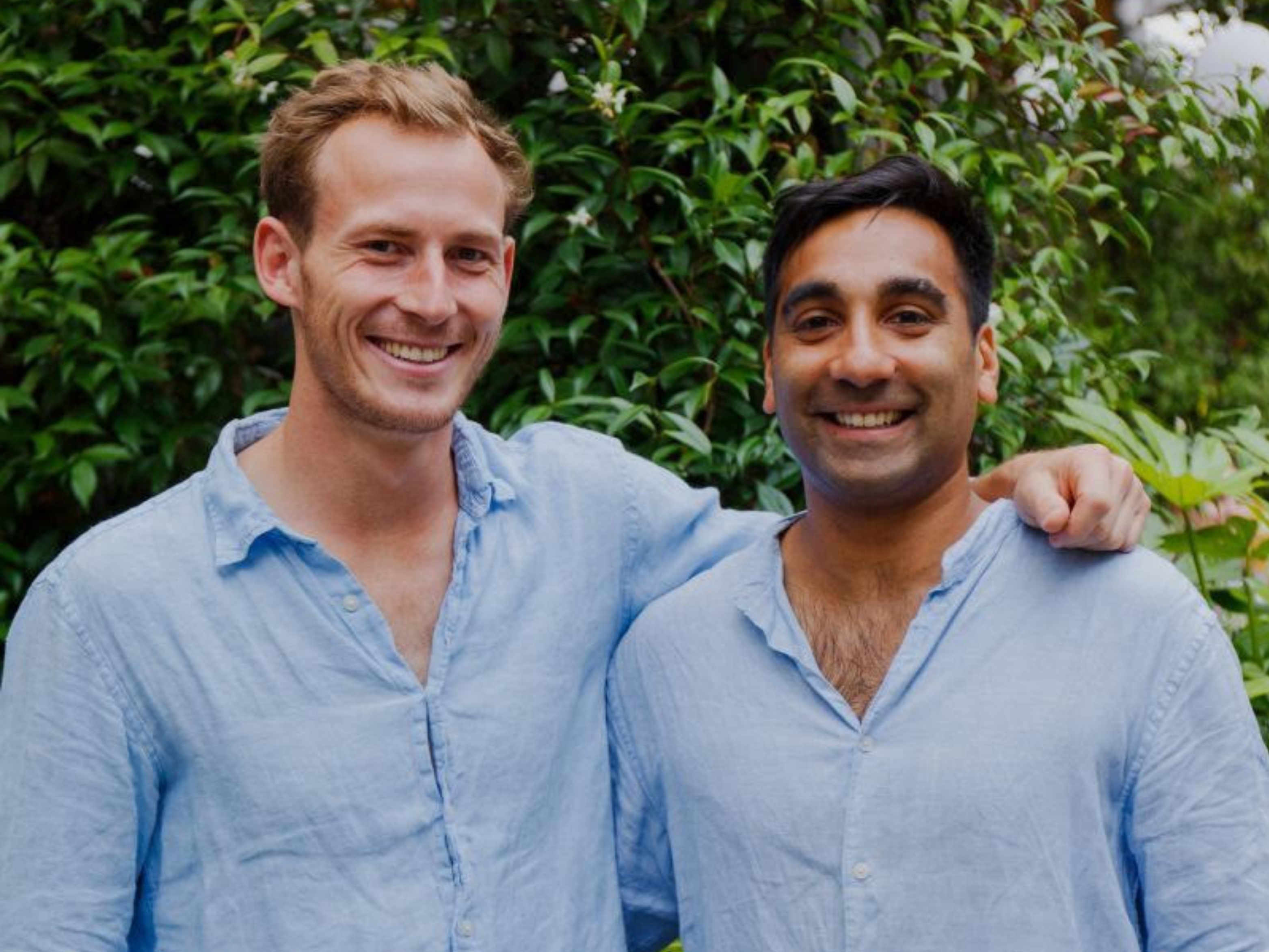Table of contents
- Matthew Sarre & Kabir Bali
- London, United Kingdom
- Business started in 2020
- 13 Employees
- 7 figures revenue in USD
- 10,000 website visitors per month
- Bootstrapped
- Jumpstart
Matthew what’s your backstory?
I grew up in London and went to university in Bristol, where I studied Economics. Most economics grads head into consulting or banking—I chose consulting as the “least-worst” option and spent three years at BCG (Boston Consulting Group). After more hours than I could bear making PowerPoint slides, and raising my cortisol levels with the stress of it all, I realised I didn’t love consulting.
So, I started looking for another career and somehow stumbled upon WWD (aka Wizarding World Digital). Yep, somehow I ended up joining a quasi-Harry-Potter-esque startup (a JV between Warner Brothers and J.K. Rowling).
This startup experience was very different, and much better. That contrast made me wonder why there wasn’t already a more conventional path into startups. And so, I set out to build one, along with my co-founder, Kabir.

What does Jumpstart do and how did you come up with the idea?
Jumpstart's mission has always been pretty consistent: legitimising startups as a career path for people early in their working life. That said, the actual idea and execution of that mission have evolved. A lot.
Our first “idea” was laughably different. We planned to recruit a highly selective pool of recent graduates, train them for three months, and then place them in four six-month rotations across different startups, essentially a law firm-style graduate programme. We asked around and quickly discovered this was a terrible idea. Candidates would join a startup, spend six months ramping up, and then leave just as they started adding value.
Where we’ve landed is a pre-vetted platform that handpicks the top 1–2% of candidates from thousands of applicants each month and matchmakes them with startups. This works for candidates because they can stand out from the crowd and get interviews and job offers quickly. It works for startups too, as they avoid the laborious process of sorting the wheat from the chaff. On top of that, we surface richer signals, like candidate videos, that startups find really useful.

How did you acquire your first 20 startups and candidates?
We launched in lockdown. Startups weren’t hiring; recent grads had bleak prospects, so candidate supply wasn’t the issue. A Cambridge Careers post brought 20–30 applicants on day one, and applications quickly scaled into the thousands (the challenge was selecting the top ~20).
On the startup side, we began with almost no network. I reached out to anyone in my network who was in some way adjacent to startups. It was somewhat fortunate that this was during lockdown: people were generous with 20-minute Zooms. And when I ended each call by asking, “Who do you know in the startup world that I should speak to about Jumpstart?”, it built a slow viral loop that grew over time. Once we had built enough critical mass and selected our first pool of exceptional candidates, showing founders that we had those profiles made the pitch a lot easier.
What feedback did you get early on, and how did it shape your next steps?
Early feedback was blunt: our rotation model was unworkable, so we dropped it. From then on, we gathered feedback from every startup and candidate, iterating on the training, matchmaking, and selection process.
One key insight was that candidates weren’t excited by certain sectors (like “cybersecurity”) when all they had to go on were job descriptions. But when founders told their stories live, the energy flipped. We started having startups pitch their companies and roles directly to our pre-selected cohorts, and it worked. That’s now a core feature.
It’s also worth saying that our attitude to feedback has shifted. Before, we treated it as gospel. Now, we take it with a pinch of salt. Henry Ford’s line — “If I had asked people what they wanted, they would have said faster horses” — is worth keeping in mind.

What distribution channels have been the most effective for reaching your target audience?
Startups: Word of mouth has been the most productive, nurturing relationships with founders who’ve been hired via Jumpstart and asking them to share in WhatsApp groups or on LinkedIn. My own LinkedIn posting has also been effective. We’re now layering in outbound, paid ads, events, and partnerships.
Candidates: Word of mouth again, plus LinkedIn paid ads for volume. The quality of referrals is very high (high flyers hang out with other high flyers)
In short, LinkedIn and referrals have driven most growth across both sides of the equation, although there are still lots of channels we haven’t fully explored.
If you could only use one channel to reach your audience, which would it be, and why?
Word of mouth: it forces you to build a product people actually want. Strongly suggest leaning into that at the beginning as you set up. Word of mouth is always somewhat of a given, though, so if not that, LinkedIn.
What’s your top tip for standing out in such a tough space?
Two things: (1) a relentless focus on quality and (2) neither Kabir nor I comes from traditional recruitment backgrounds. We don’t copy recruiter playbooks. We invest in tech to automate where it helps, we trust our clients (e.g. we allow them to have access to 100% of our candidates) and we trust our candidates (e.g. we don't schedule interviews on candidates' behalf), and ensure that our incentive model is aligned to maintaining a very high bar (we only get paid if the hire works out after 90 days). That differentiates both our product and our process from “traditional recruiters.”

How did you build and maintain trust on both sides of the marketplace?
Candidates: We spent time with them, were transparent, and leaned on our credible backgrounds (BCG and Deloitte). Early Zooms made it clear we were building something real.
Startups: We showed, not told — putting exceptional candidates in front of them. Our very first candidate (top of his year at Cambridge in engineering, GB gymnastics, built a company in lockdown) set the tone; quality builds trust fast.
Jumpstart’s alumni network is a big strength, how did you build that community?
Traditional grad schemes have strong peer networks; startups often don’t. We wanted to give our people that same peer group and mentorship layer. In the early days, we brute-forced it, lots of events, putting in our time and budget, and yes, free drinks to get people together. That community has become a place where people can share, learn, and vent — and over time it’s turned into a real growth engine through referrals and credibility.
How do you prevent founder churn, and do you have a retention playbook?
First off, we’re not B2B SaaS. A great outcome is a startup actually dropping off the platform after a couple of weeks of heavy use (provided they hire!). We don’t want to drag out hiring for subscription revenue.
What we do care about: staying top-of-mind when they next hire. We use platform reminders and a strong LinkedIn presence, plus personal intervention via account managers to answer questions and get founders over the line. Automate what doesn’t need a human; add personal touch where it does.

What are your plans for Jumpstart in the future?
Our goal is to become the one-stop shop for startup hiring in the UK, and potentially beyond.
The next big step is becoming the go-to hub for finding top software engineers. To make that happen, we’re focusing on things that compound in value over time: brand, platform, and automations. Alongside that, we’re building a high-quality team aligned around a tight set of prioritised goals.
What specific tools, software, or resources have been most helpful in growing Jumpstart?
Tools: Airtable and automation tools like Zapier and Make, which linked our data and let us test an MVP and then scale ops. They're still the backbone of our product today.
YC Startup School’s videos were also invaluable: build product, talk to users. Repeat.
Any promotions you would like to add for Founderoo readers?
£500 credit for your first hire - just mention it on the call with the Jumpstart team.

What are some of the biggest lessons you’ve learned from building Jumpstart?
1. You can’t do it alone; the team is everything.
2. Iteration (and ripping up things that you've previously built) isn’t going backwards; it’s progress.
3. Big, ambitious targets pull the team further than safe ones, especially with the right incentives.
What drives you to do what you do?
Seeing things build, grow, and improve. When I was younger, I collected shells and “gems” from the beach, bits of sea-smoothed broken glass. At university, I was motivated by improving my tennis. That same mentality fuels my drive at Jumpstart: breaking through the next milestone and learning new things along the way.
Any quotes or principles you live by?
“Race your own race.”
It’s easy to look at the lane next to you; it's better to focus on your path.
“Be good.”
Don’t do anything you wouldn’t want your parents or friends to see. Act with integrity and be kind; it pays back over the long term.
Your links + socials
Take a sneak peek of of the top 1% of candidates

%20Logo.svg)




